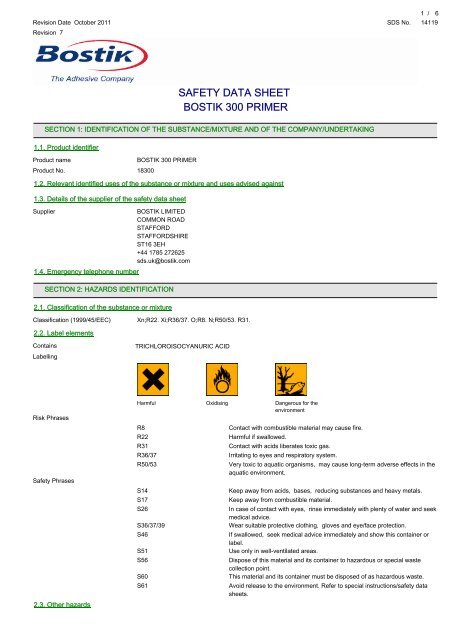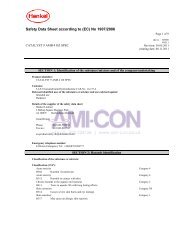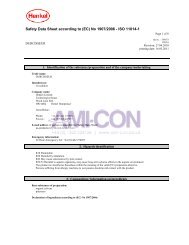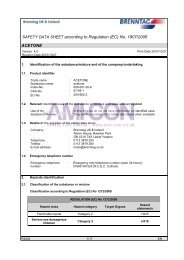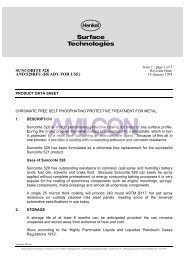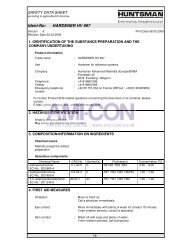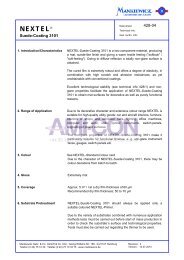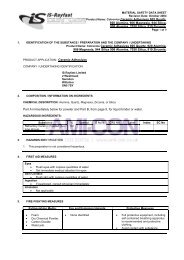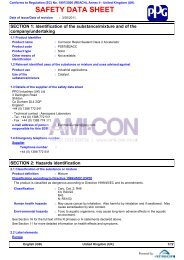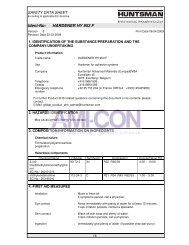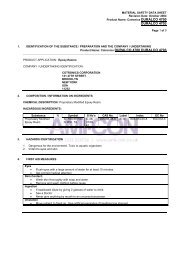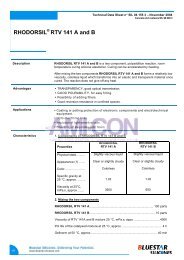SAFETY DATA SHEET BOSTIK 300 PRIMER - eANIXTER
SAFETY DATA SHEET BOSTIK 300 PRIMER - eANIXTER
SAFETY DATA SHEET BOSTIK 300 PRIMER - eANIXTER
Create successful ePaper yourself
Turn your PDF publications into a flip-book with our unique Google optimized e-Paper software.
Revision Date October 2011<br />
Revision 7<br />
1 / 6<br />
SDS No. 14119<br />
<strong>SAFETY</strong> <strong>DATA</strong> <strong>SHEET</strong><br />
<strong>BOSTIK</strong> <strong>300</strong> <strong>PRIMER</strong><br />
SECTION 1: IDENTIFICATION OF THE SUBSTANCE/MIXTURE AND OF THE COMPANY/UNDERTAKING<br />
1.1. Product identifier<br />
Product name<br />
Product No. 18<strong>300</strong><br />
<strong>BOSTIK</strong> <strong>300</strong> <strong>PRIMER</strong><br />
1.2. Relevant identified uses of the substance or mixture and uses advised against<br />
1.3. Details of the supplier of the safety data sheet<br />
Supplier<br />
1.4. Emergency telephone number<br />
<strong>BOSTIK</strong> LIMITED<br />
COMMON ROAD<br />
STAFFORD<br />
STAFFORDSHIRE<br />
ST16 3EH<br />
+44 1785 272625<br />
sds.uk@bostik.com<br />
SECTION 2: HAZARDS IDENTIFICATION<br />
2.1. Classification of the substance or mixture<br />
Classification (1999/45/EEC) Xn;R22. Xi;R36/37. O;R8. N;R50/53. R31.<br />
2.2. Label elements<br />
Contains<br />
Labelling<br />
TRICHLOROISOCYANURIC ACID<br />
Risk Phrases<br />
Safety Phrases<br />
2.3. Other hazards<br />
Harmful Oxidising Dangerous for the<br />
environment<br />
R8<br />
R22<br />
R31<br />
Contact with combustible material may cause fire.<br />
Harmful if swallowed.<br />
Contact with acids liberates toxic gas.<br />
R36/37 Irritating to eyes and respiratory system.<br />
R50/53 Very toxic to aquatic organisms, may cause long-term adverse effects in the<br />
aquatic environment.<br />
S14<br />
S17<br />
S26<br />
S36/37/39<br />
S46<br />
S51<br />
S56<br />
S60<br />
S61<br />
Keep away from acids, bases, reducing substances and heavy metals.<br />
Keep away from combustible material.<br />
In case of contact with eyes, rinse immediately with plenty of water and seek<br />
medical advice.<br />
Wear suitable protective clothing, gloves and eye/face protection.<br />
If swallowed, seek medical advice immediately and show this container or<br />
label.<br />
Use only in well-ventilated areas.<br />
Dispose of this material and its container to hazardous or special waste<br />
collection point.<br />
This material and its container must be disposed of as hazardous waste.<br />
Avoid release to the environment. Refer to special instructions/safety data<br />
sheets.
<strong>BOSTIK</strong> <strong>300</strong> <strong>PRIMER</strong><br />
2 / 6<br />
SDS No. 14119<br />
SECTION 3: COMPOSITION/INFORMATION ON INGREDIENTS<br />
3.2. Mixtures<br />
TRICHLOROISOCYANURIC ACID 60-100%<br />
CAS-No.: 87-90-1 EC No.: 201-782-8<br />
Classification (EC 1272/2008)<br />
Ox. Sol. 2 - H272<br />
EUH031<br />
Acute Tox. 4 - H302<br />
Eye Irrit. 2 - H319<br />
STOT Single 3 - H335<br />
Aquatic Acute 1 - H400<br />
Aquatic Chronic 1 - H410<br />
Classification (67/548/EEC)<br />
O;R8<br />
Xn;R22<br />
Xi;R36/37<br />
R31<br />
N;R50/53<br />
The Full Text for all R-Phrases and Hazard Statements are Displayed in Section 16.<br />
SECTION 4: FIRST AID MEASURES<br />
4.1. Description of first aid measures<br />
Inhalation<br />
Move the exposed person to fresh air at once. For breathing difficulties oxygen may be necessary. Get medical attention.<br />
Ingestion<br />
DO NOT induce vomiting. Get medical attention immediately.<br />
Skin contact<br />
Remove affected person from source of contamination. Wash off promptly and flush contaminated skin with water. Promptly remove<br />
clothing if soaked through and flush skin with water. Get medical attention if any discomfort continues.<br />
Eye contact<br />
Rinse the eye with water immediately. Continue to rinse for at least 15 minutes. Get medical attention immediately. Continue to rinse.<br />
4.2. Most important symptoms and effects, both acute and delayed<br />
4.3. Indication of any immediate medical attention and special treatment needed<br />
SECTION 5: FIREFIGHTING MEASURES<br />
5.1. Extinguishing media<br />
Extinguishing media<br />
Dry chemicals, sand, dolomite etc.<br />
5.2. Special hazards arising from the substance or mixture<br />
Specific hazards<br />
Fire or high temperatures create: Toxic gases and fumes<br />
5.3. Advice for firefighters<br />
Special Fire Fighting Procedures<br />
Fight advanced or massive fires from safe distance or protected location. Use supplied air respirator if product is involved in a fire. Keep<br />
up-wind to avoid fumes.<br />
Protective equipment for fire-figthers<br />
Wear self contained breathing apparatus<br />
SECTION 6: ACCIDENTAL RELEASE MEASURES<br />
6.1. Personal precautions, protective equipment and emergency procedures<br />
Ensure adequate ventilation. Wear self contained breathing apparatus. Wear personal protective equipment. Avoid skin and eye contact.<br />
6.2. Environmental precautions<br />
Prevent entry into drains and water courses.<br />
6.3. Methods and material for containment and cleaning up
<strong>BOSTIK</strong> <strong>300</strong> <strong>PRIMER</strong><br />
Stop leak if possible without risk. DO NOT touch spilled material! Shovel into dry containers. Cover and move the containers. Flush the<br />
area with water. Use sealed containers for reclamation or dispose of at a licenced hazardous waste collection point. Avoid contact with<br />
water.<br />
6.4. Reference to other sections<br />
SECTION 7: HANDLING AND STORAGE<br />
7.1. Precautions for safe handling<br />
Keep away from heat, sparks and open flame. Avoid spilling, skin and eye contact. Ventilate well, avoid breathing vapours. Use<br />
approved respirator if air contamination is above accepted level.<br />
7.2. Conditions for safe storage, including any incompatibilities<br />
Isolate from other materials. Store in tightly closed original container in a dry, cool and well-ventilated place.<br />
Storage Class<br />
Oxidiser storage.<br />
7.3. Specific end use(s)<br />
SECTION 8: EXPOSURE CONTROLS/PERSONAL PROTECTION<br />
8.1. Control parameters<br />
3<br />
/<br />
6<br />
SDS No. 14119<br />
Ingredient Comments<br />
WEL = Workplace Exposure Limits<br />
8.2. Exposure controls<br />
Protective equipment<br />
Process conditions<br />
Use engineering controls to reduce air contamination to permissible exposure level.<br />
Hand protection<br />
Chemical resistant gloves required for prolonged or repeated contact.<br />
Eye protection<br />
Wear dust resistant safety goggles where there is danger of eye contact.<br />
Other Protection<br />
Wear appropriate clothing to prevent reasonably probable skin contact.<br />
Hygiene measures<br />
DO NOT SMOKE IN WORK AREA! Wash at the end of each work shift and before eating, smoking and using the toilet. Use appropriate<br />
skin cream to prevent drying of skin.<br />
SECTION 9: PHYSICAL AND CHEMICAL PROPERTIES<br />
9.1. Information on basic physical and chemical properties<br />
Appearance<br />
Colour<br />
Solubility<br />
pH-Value, Conc. Solution 3<br />
9.2. Other information<br />
Powder, dust Granular<br />
White / off-white.<br />
SECTION 10: STABILITY AND REACTIVITY<br />
10.1. Reactivity<br />
10.2. Chemical stability<br />
10.3. Possibility of hazardous reactions<br />
10.4. Conditions to avoid<br />
Reacts with water. To produce Chlorine gas<br />
Oxidising, avoid contact with reducing agents. Avoid heat, flames and other sources of ignition.
10.5. Incompatible materials<br />
<strong>BOSTIK</strong> <strong>300</strong> <strong>PRIMER</strong><br />
4 / 6<br />
SDS No. 14119<br />
Materials To Avoid<br />
Water, steam, water mixtures. Strong acids. Strong alkalis.<br />
10.6. Hazardous decomposition products<br />
SECTION 11: TOXICOLOGICAL INFORMATION<br />
11.1. Information on toxicological effects<br />
Inhalation<br />
Irritating to respiratory system. Vapour may affect central nervous system and cause headache, discomfort, vomiting or intoxication.<br />
Ingestion<br />
Central nervous system depression. Drowsiness, dizziness, disorientation, vertigo.<br />
Skin contact<br />
Slightly irritating.<br />
Eye contact<br />
May cause severe irritation to eyes.<br />
SECTION 12: ECOLOGICAL INFORMATION<br />
Ecotoxicity<br />
Contamination of the terrestrial and aquatic environments should be avoided<br />
12.1. Toxicity<br />
12.2. Persistence and degradability<br />
12.3. Bioaccumulative potential<br />
12.4. Mobility in soil<br />
12.5. Results of PBT and vPvB assessment<br />
12.6. Other adverse effects<br />
SECTION 13: DISPOSAL CONSIDERATIONS<br />
General information<br />
Do not store damp or wet material<br />
13.1. Waste treatment methods<br />
Dispose of waste and residues in accordance with local authority requirements.<br />
SECTION 14: TRANSPORT INFORMATION<br />
14.1. UN number<br />
UN No. (ADR/RID/ADN) 2468<br />
UN No. (IMDG) 2468<br />
UN No. (ICAO) 2468<br />
14.2. UN proper shipping name<br />
Proper Shipping Name<br />
TRICHLOROISOCYANURIC ACID, DRY<br />
14.3. Transport hazard class(es)<br />
ADR/RID/ADN Class 5.2<br />
ADR/RID/ADN Class<br />
Class 5.2: Organic peroxides.<br />
ADR Label No. 5.2<br />
IMDG Class 5.2<br />
ICAO Class/Division 5.2<br />
Transport Labels
<strong>BOSTIK</strong> <strong>300</strong> <strong>PRIMER</strong><br />
5 / 6<br />
SDS No. 14119<br />
OXIDIZING<br />
AGENT<br />
5.1<br />
14.4. Packing group<br />
Not applicable.<br />
14.5. Environmental hazards<br />
Environmentally Hazardous Substance/Marine Pollutant<br />
14.6. Special precautions for user<br />
14.7. Transport in bulk according to Annex II of MARPOL73/78 and the IBC Code<br />
SECTION 15: REGULATORY INFORMATION<br />
15.1. Safety, health and environmental regulations/legislation specific for the substance or mixture<br />
Statutory Instruments<br />
The Chemicals (Hazard Information and Packaging for Supply) Regulations 2009 (S.I 2009 No. 716). Control of Substances Hazardous to<br />
Health.<br />
Approved Code Of Practice<br />
Safety Data Sheets for Substances and Preparations. Classification and Labelling of Substances and Preparations Dangerous for Supply.<br />
Guidance Notes<br />
Workplace Exposure Limits EH40. CHIP for everyone HSG(108). Introduction to Local Exhaust Ventilation HS(G)37.<br />
15.2. Chemical Safety Assessment<br />
SECTION 16: OTHER INFORMATION<br />
General information<br />
This product should be used as directed by Bostik Ltd. For further information consult the product data sheet or contact Technical Services.<br />
Information Sources<br />
This safety data sheet was compiled using current safety information supplied by distributor of raw materials.<br />
Revision Comments<br />
NOTE: Lines within the margin indicate significant changes from the previous revision. This safety data sheet supersedes all previous<br />
issues and users are cautioned to ensure that it is current. Destroy all previous data sheets and if in doubt contact Bostik Limited.<br />
Issued By<br />
Approved LJ<br />
Revision Date October 2011<br />
Revision 7<br />
Date September 2003<br />
Risk Phrases In Full<br />
R31<br />
R8<br />
R22<br />
R36/37<br />
R50/53<br />
Contact with acids liberates toxic gas.<br />
Contact with combustible material may cause fire.<br />
Harmful if swallowed.<br />
Irritating to eyes and respiratory system.<br />
Very toxic to aquatic organisms, may cause long-term adverse effects in the aquatic environment.
Hazard Statements In Full<br />
H319<br />
EUH031<br />
H302<br />
H335<br />
H272<br />
H410<br />
H400<br />
<strong>BOSTIK</strong> <strong>300</strong> <strong>PRIMER</strong><br />
Causes serious eye irritation.<br />
Contact with acids liberates toxic gas.<br />
Harmful if swallowed.<br />
May cause respiratory irritation.<br />
May intensify fire; oxidiser.<br />
Very toxic to aquatic life with long lasting effects.<br />
Very toxic to aquatic life.<br />
6 / 6<br />
SDS No. 14119


